1. General introduction about Cat Cat village
1.1. Location of Cat Cat village
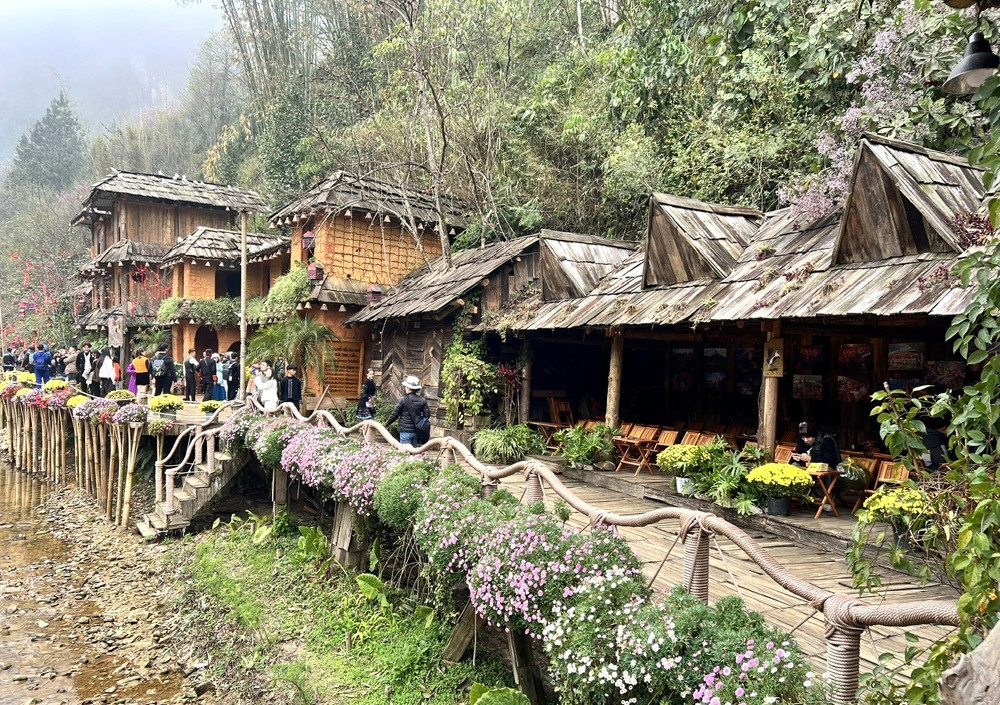
A peaceful village nestled beside high mountains and a gentle stream. (Source: Collected)
Cat Cat Village is located in Ta Van commune, only about 2 to 3 km from the center of Sa Pa, making it very convenient for tourists to travel. From the center, you can ride a motorbike for about 15 minutes or choose trekking to both exercise and admire the majestic mountain and forest scenery on the way down to the village.
Cat Cat Village lies peacefully at the foot of Hoang Lien Son mountain, with the H'Mong people being the majority ethnic group in the village. It offers tourists a fresh space, a cool climate year-round, and the cultural beauty deeply characteristic of the H'Mong people. In autumn and winter, the afternoon smoke from haystacks after the harvest drifts lazily through the valley, creating a hazy, poetic scene. When the mist clears, the village reappears with the vibrant colors of brocade dresses and traditional wooden houses. With its unique characteristics of the Northwestern highland villages, Cat Cat Village is an unmissable destination for tourists visiting the misty land of Sa Pa.
1.2. History of formation and origin of the name Cat Cat Village
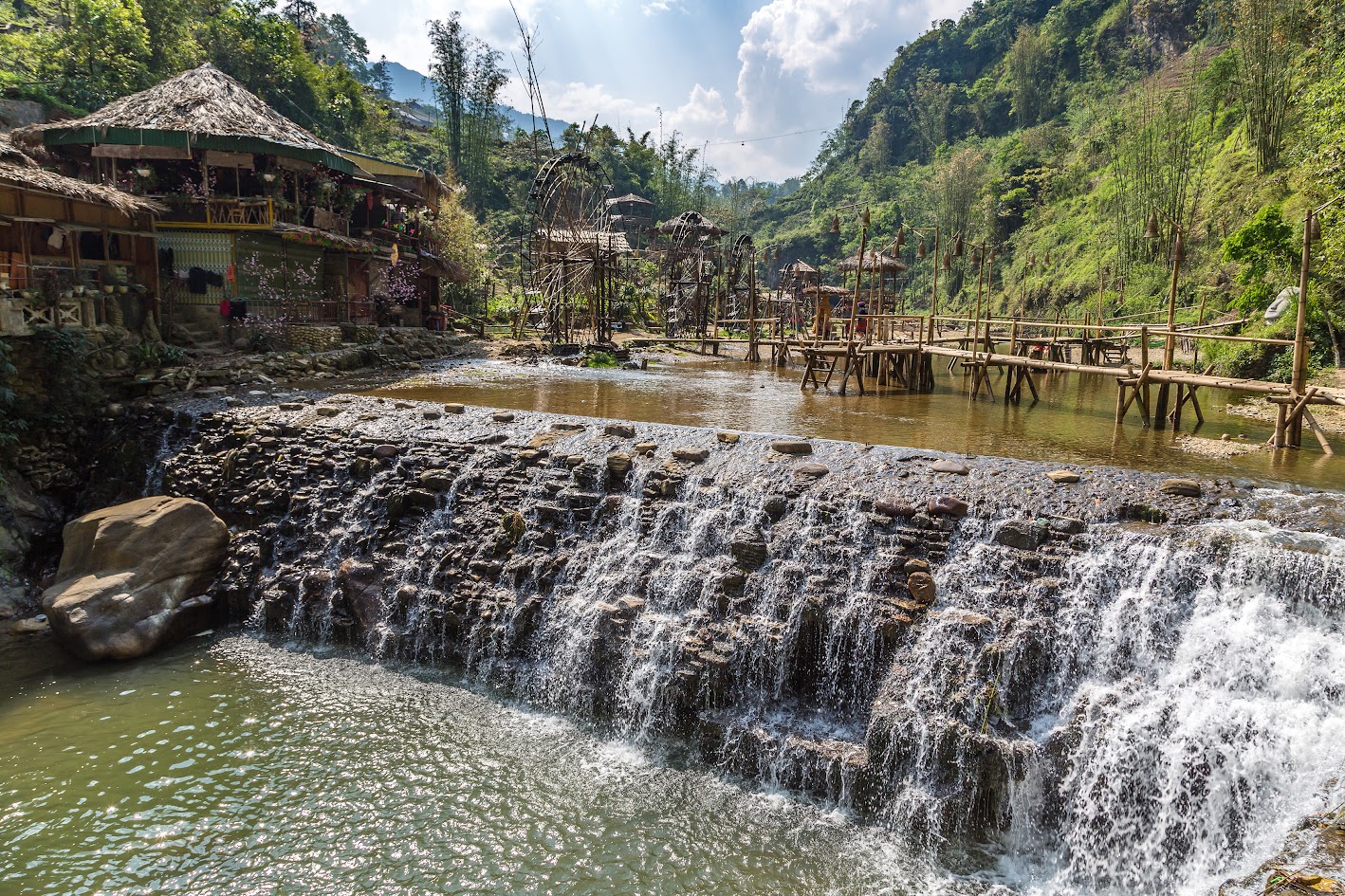
Poetic waterfall inside Cat Cat village. (Source: Collected)
Cat Cat village was formed in the mid-19th century, making it one of the oldest ancient villages in the northern mountainous region. In the early 20th century, when the French set foot in Sapa, they noticed the fresh, cool climate year-round and the majestic natural scenery, so they chose it as a resort for officials. They discovered a beautiful waterfall flowing through the village and named it Catscat, which means waterfall in French. From then on, the name Cat Cat was born and has been used to this day.
Not only does it boast poetic scenery, but Cat Cat village is also a place that preserves many cultural and historical values of the Mong ethnic people. During the resistance period, this land witnessed many important milestones of the nation. The imprint of French culture also left a deep influence on the architecture and daily life of the people here.
2. How to get to Cat Cat village
2.1. Instructions to get to Sapa
To reach the misty land of Sapa, tourists can choose various means of transport depending on their time and personal preferences. Among these, trains, sleeper buses, and self-driving cars are the most popular.
Trains are a favorite choice for many tourists due to the relaxing and safe experience. The journey from Hanoi station to Lao Cai station takes about 8 hours, after which you continue for another 40 km by bus or taxi to reach the center of Sapa. Train ticket prices range from 300,000 to 500,000 VND depending on the seat class. Some reputable train companies highly rated include Chapa Express, Victoria Express, Vietnam Railways Corporation…

Comfortable sleeper cabin of the Chapa Express train to Lao Cai. (Source: Collected)
Sleeper buses are suitable for those who want to save time. The Hanoi – Sa Pa route currently has many high-quality bus companies such as Sapa Express, Queen Cafe, Ha Son Hai Van... Travel time is only about 5 to 6 hours, with ticket prices ranging from 350,000 to 500,000 VND. Tourists should choose to depart at night to rest on the bus and arrive in Sa Pa early in the morning, starting the day's exploration.
Self-driving is an option for those who love freedom and want to experience the spectacular mountain passes of the Northwest. The modern Hanoi – Lao Cai expressway shortens travel time to only about 5 to 6 hours. However, due to Sa Pa's weather often having thick fog and winding mountain roads, you should drive carefully, adhere to speed limits, and have a companion to ensure safety throughout the trip.
2.2. Moving from Sa Pa center to Cat Cat village
From Sa Pa center, tourists can easily reach Cat Cat village by various means such as electric cars, motorbikes, or taxis, depending on their needs and desired experience.
Electric cars are a convenient and environmentally friendly option, very suitable for families with young children or the elderly. The electric car route runs directly from Sa Pa central square to the entrance of Cat Cat village, with a travel time of only about 10 to 15 minutes. Ticket prices range from 50,000 to 100,000 VND per person. This mode of transport operates all day, allowing tourists to comfortably arrange their schedules.
Renting a motorbike is a favorite choice for those who love to explore and be proactive in their journey. The motorbike rental price is only about 120,000 to 150,000 VND per day, suitable for couples or groups of young friends.
Taxis are a convenient option for large groups or families traveling together. It only takes 10 minutes to reach Cat Cat village safely and comfortably. The average taxi price is from 7,000 to 10,000 VND/km. Some popular taxi companies in Sa Pa that tourists can refer to include:
- Taxi Xanh Sa Pa: 0214 3 63 63 63
- Mai Linh Sa Pa: 0214 3 833 833
- Taxi Fansipan: 0214 3 62 62 62
3. Exploring cultural life in Cat Cat village
3.1. Traditional Festivals
Cat Cat village is not only famous for its poetic natural scenery but also a place that preserves many traditional festivals imbued with the ethnic Mông identity. Each festival reflects a rich spiritual life, a love for nature, and a deep belief in the guardian spirits of the mountains and forests.

The festive atmosphere is bustling in the early days of the year. (Source: Collected)
At the beginning of the year, the villagers organize the Gau Tao Festival, one of the largest and most sacred festivals. This is an occasion to pray for abundant harvests, good health, and peace for families. In the middle of the year, the Mong people organize the Nao Song Festival, which signifies community connection. During this festival, everyone sings, dances the khen, and participates in folk games such as throwing pao, tug of war, and spinning tops.
Besides, the forest worship ceremony is also a unique cultural beauty. People believe that spirits reside in every forest, protecting the village from natural disasters and wild animals. The worship ceremony not only carries religious significance but also reflects a deep awareness of environmental protection and forest ecosystem preservation.
During festival days, tourists can immerse themselves in the vibrant local life, practice playing the khen, and wear colorful brocade costumes. Every moment in Cat Cat village is a memorable experience, helping you understand more about the life and customs of the people in the mountainous region.
3.2. Earthen Wall Houses Architecture
Living in mountainous areas with cold climates year-round, the H'Mong people in Cat Cat village have created earthen wall houses, a characteristic architectural style that helps them withstand harsh winters. These houses have traditional yin-yang tiled roofs, each typically spanning two to three rooms and having two main doors. Visitors will notice that despite their simplicity, earthen wall houses are incredibly special: they stay warm in winter and cool in summer.
3.3. Traditional Handicrafts
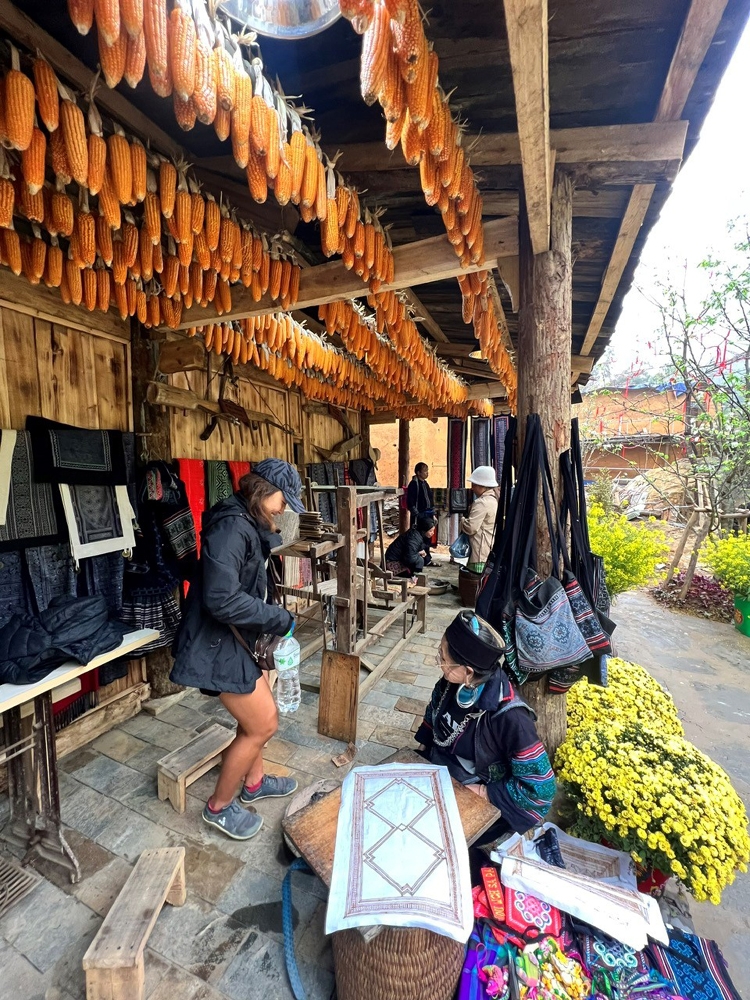
Tourists are delighted to explore the traditional brocade weaving craft. (Source: Collected)
Each Hmong family dedicates a private space for fabric weaving and handicraft making, demonstrating the important role of traditional crafts in daily life.
The linen weaving and brocade making craft is done entirely by hand, going through many meticulous stages such as growing flax, spinning yarn, indigo dyeing, and then carefully crafting each pattern on the fabric. The motifs on the brocade are often associated with people's lives, such as rice ears, mountains, the sun, and ferns...
Silver carving is also very developed, nổi bật with exquisite jewelry such as necklaces, earrings, and skirt belts meticulously handcrafted. Tourists can buy products directly from the skillful hands of artisans, bringing home a meaningful gift while also contributing to supporting the local economy.
3.4. Daily life of the Hmong people

Specialties of the H'Mong people of Sa Pa. (Source: Collected)
The rhythm of life here still retains traditional features: in the morning, people go to the fields to farm, women weave fabric, men craft silver and go to the forest. In the evening, the whole family gathers around the fire. Today, people have combined tourism with opening homestays, both developing the economy and preserving local culture.
Visitors can participate in many interesting experiences such as indigo dyeing, making corn cakes, sticky rice cakes, or trying to weave fabric on a wooden loom. Enjoying dinner with characteristic dishes like 'lon cap nach' (pig carried on the arm), 'men men' (steamed cornmeal), and 'thang co' (horse meat stew) amidst the peaceful mountain scenery will bring unforgettable emotions about the simple life of the H'Mong people.
4. Must-visit check-in spots in Cat Cat village
4.1. Tien Sa Waterfall
Tien Sa Waterfall is considered the heart of Cat Cat village, where the white water cascades down from a height of nearly 20 meters onto the clear blue lake below. This majestic waterfall originates from the water source in the Hoang Lien Son mountain range and Tien stream, combining to create a landscape that is both poetic and magnificent.
The waterfall's water is clear all year round, flowing over moss-covered rocks and then splashing white foam in the valley. This is a favorite stop for tourists visiting Cat Cat to admire the wild beauty and capture memorable moments amidst the Northwest nature.
4.2. Terraced fields
A favorite spot for tourists in Cat Cat village is the vast terraced fields, stretching across the hillsides. The terraced fields surrounding Cat Cat village change their appearance with each season, offering captivating beauty year-round. In the ripe rice season (September - October), the entire valley is covered in a shimmering golden hue. In the water-flooding season (April - May), the fields sparkle like mirrors reflecting the sky and clouds, and are covered in a vibrant green.
Here, visitors can stroll along small paths between the terraced fields, take souvenir photos, and observe the working life of the H'Mong people.

Lush green terraced fields during the water-pouring season. (Source: Collected)
4.4. Cat Cat Village Cultural House

Cultural house location loved by many tourists. (Source: Collected)
The Cat Cat village cultural house is built on the foundation of the old cultural house, standing out with a brilliant yellow color amidst the mountain and forest scenery. The space here is decorated with colorful incense bundles and peach and plum blossoms, bringing a cozy and familiar feeling.
With its rustic yet captivating beauty, this is a favorite stop for many tourists, both for taking check-in photos and for experiencing the characteristic atmosphere of the Northwestern villages.
4.5. Mị's House and A Phủ's House Cafes
When visiting Cat Cat village, don't forget to stop by Mị's House and A Phủ's House – two famous cafes with a rustic, highland-style space. Every corner here carries the traditional H'Mong essence mixed with a touch of modern, friendly design.
Sipping a warm cup of coffee, watching the stream babble amidst the mist, and feeling the characteristic chill of the mountains and forests will bring a sense of lightness and peace. This is also a favorite check-in spot with its poetic scenery and enchanting photo opportunities.
5. Beautiful View Homestay Suggestions in Cat Cat Village 2025
5.1. H’mong Catcat Homestay
H’mong Cat Cat Homestay is located near the center of Cat Cat village, only about 2 km from Sa Pa center, making it very convenient for tourists to travel to famous attractions like Muong Hoa valley.
The homestay is being upgraded and expanded with a capacity of about 100 guests, capable of organizing parties, events, or exchange activities upon request. The cozy space, close to nature, offers guests a comfortable and friendly resort experience.
- Reference price: 100,000 – 320,000 VND/room
- Contact: 1900 252 209
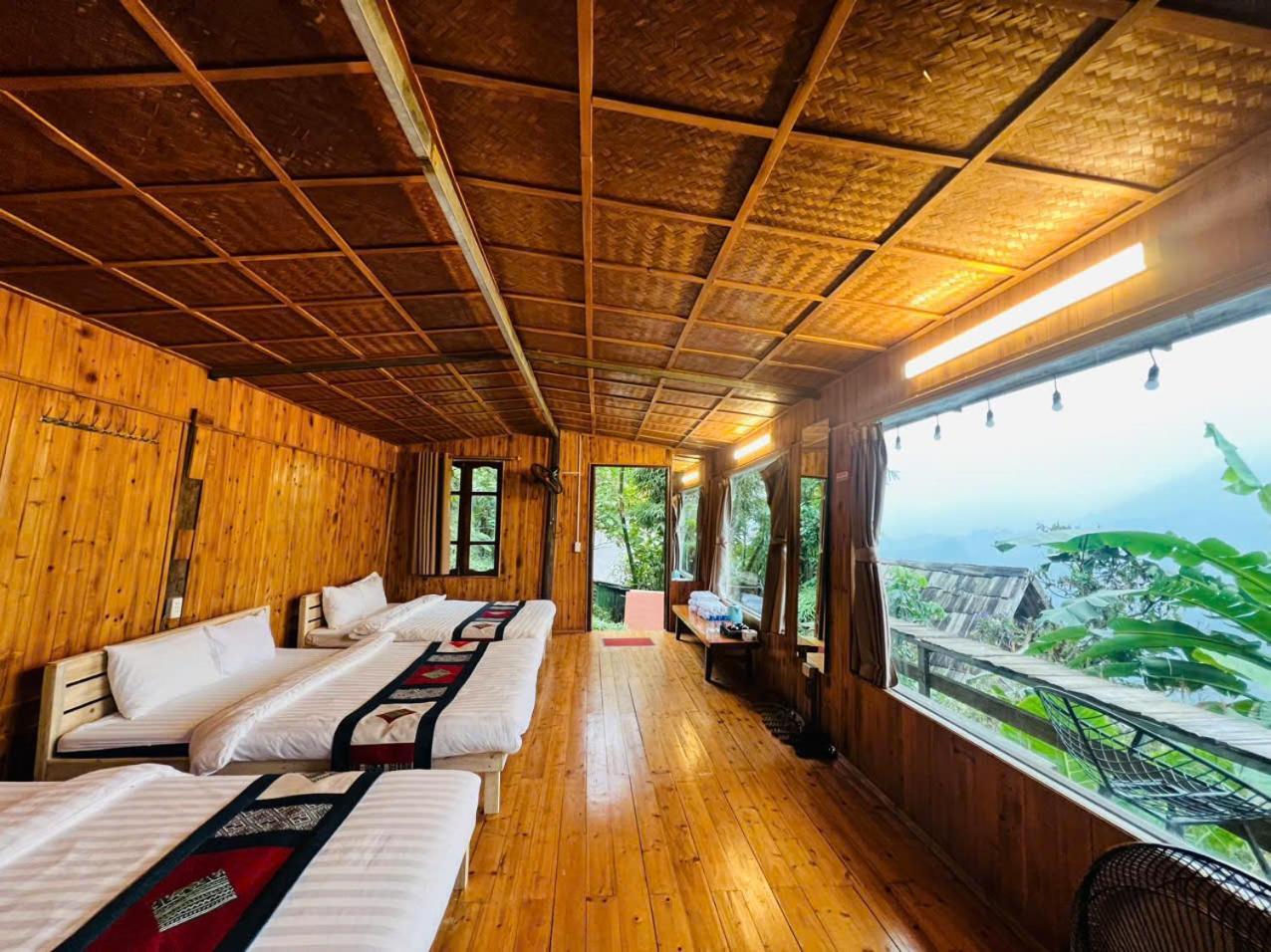
Cozy bedroom with a valley view of Hmong Catcat Homestay. (Source: Collected)
5.2. Haven Sapa Camp Site
Haven Sapa Camp Site is located on Vong Canh hill in Cat Cat village, about 1.5 km from Sa Pa. This place is considered one of the most beautiful homestays combined with cafes in Sa Pa, offering visitors a unique resting space close to nature.
- Reference price: About 150,000 VND/person
- Contact: 1900 252 209
5.3. Eco Palms House
Eco Palms House is an ideal choice for families or large groups of friends when visiting Cat Cat village. The resort has a spacious area, a cool garden, suitable for organizing barbecues or outdoor activities.
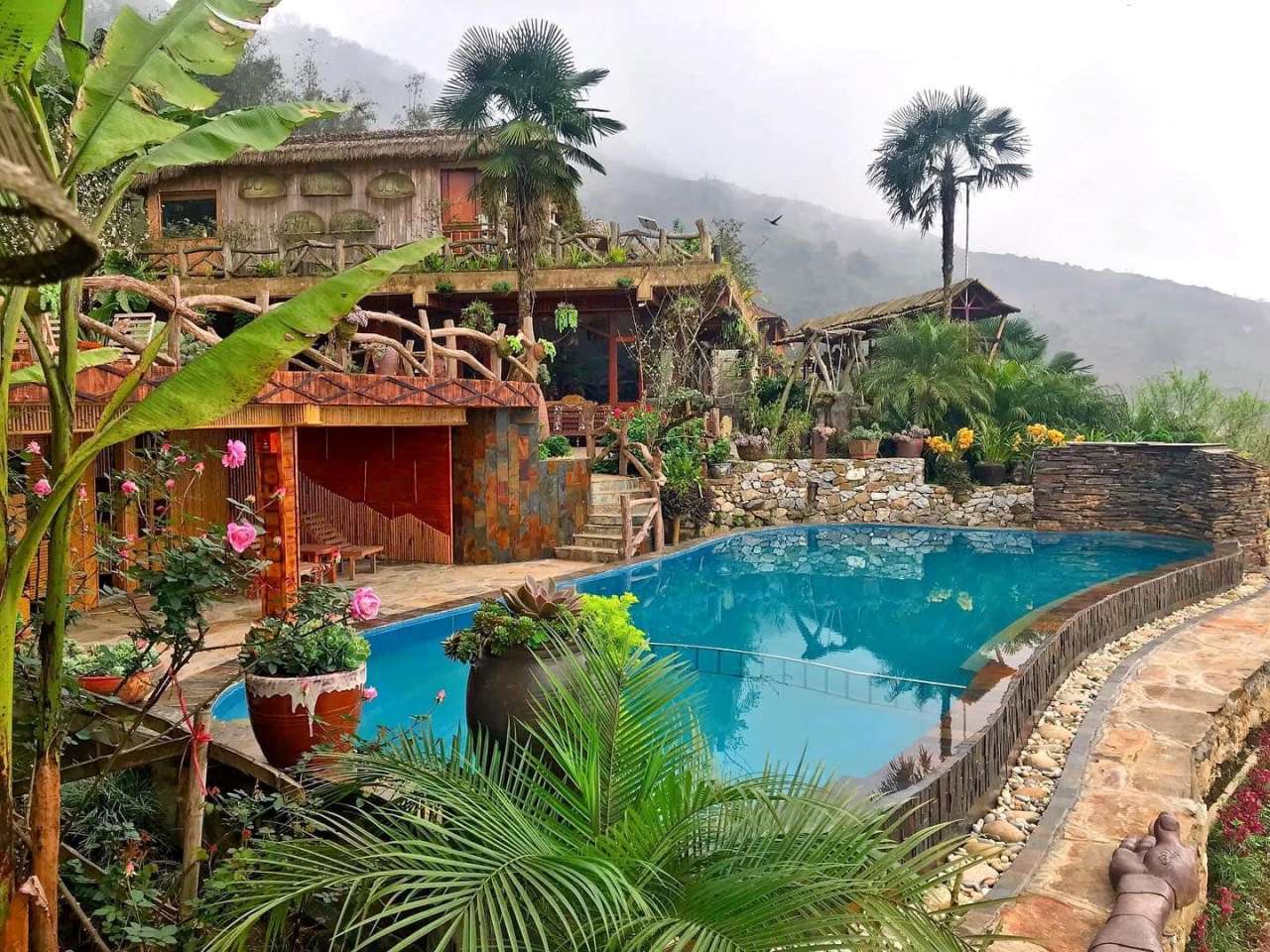
Spacious atmosphere of Eco Palms House. (Source: Collected)
The design style here is a blend of classic elements and the distinctive architecture of the H'Mong people, bringing a cozy and close-to-nature feeling.
- Reference price: 300,000 – 600,000 VND/room
- Contact for booking: 0393 399 659
5.4. Gem Valley
Gem Valley is one of the most beloved homestays in Sa Pa, serving as both accommodation and a famous cafe with a beautiful view overlooking Cat Cat village. The homestay is designed by a Hanoi-based artist couple, featuring a unique artistic style that is close to nature.
- Reference price: 200,000 – 2,500,000 VND/room
- Contact: 1900 252 209
5.5. Art House Sapa
Art House Sapa is nestled on the mountainside, offering visitors a sense of peace amidst the majestic natural scenery. Although the path is a bit winding, upon arrival, you will experience a unique 4-in-1 model combining a homestay, cafe, art exhibition space, and a lush green garden.
- Reference price: 200,000 – 500,000 VND/night
- Contact: 1900 252 209
6. 3-Day, 2-Night Sa Pa Travel Itinerary
6.1. Day 1: Exploring Cat Cat Village
Around 8 AM, you can start your journey at the entrance of Cat Cat village, head to Tien Sa waterfall to enjoy the cool air and gentle light, which is an ideal time for photos. The waterfall area, bamboo bridge, and ancient mill are all popular check-in spots.
From 10 AM to 12 PM, participate in handicraft workshops at artisans' houses in the village: experience traditional linen weaving, indigo dyeing, or silver carving. For lunch, enjoy grilled 'lon cap nach' (suckling pig carried on the shoulder), wild vegetables, and corn wine at a local restaurant.
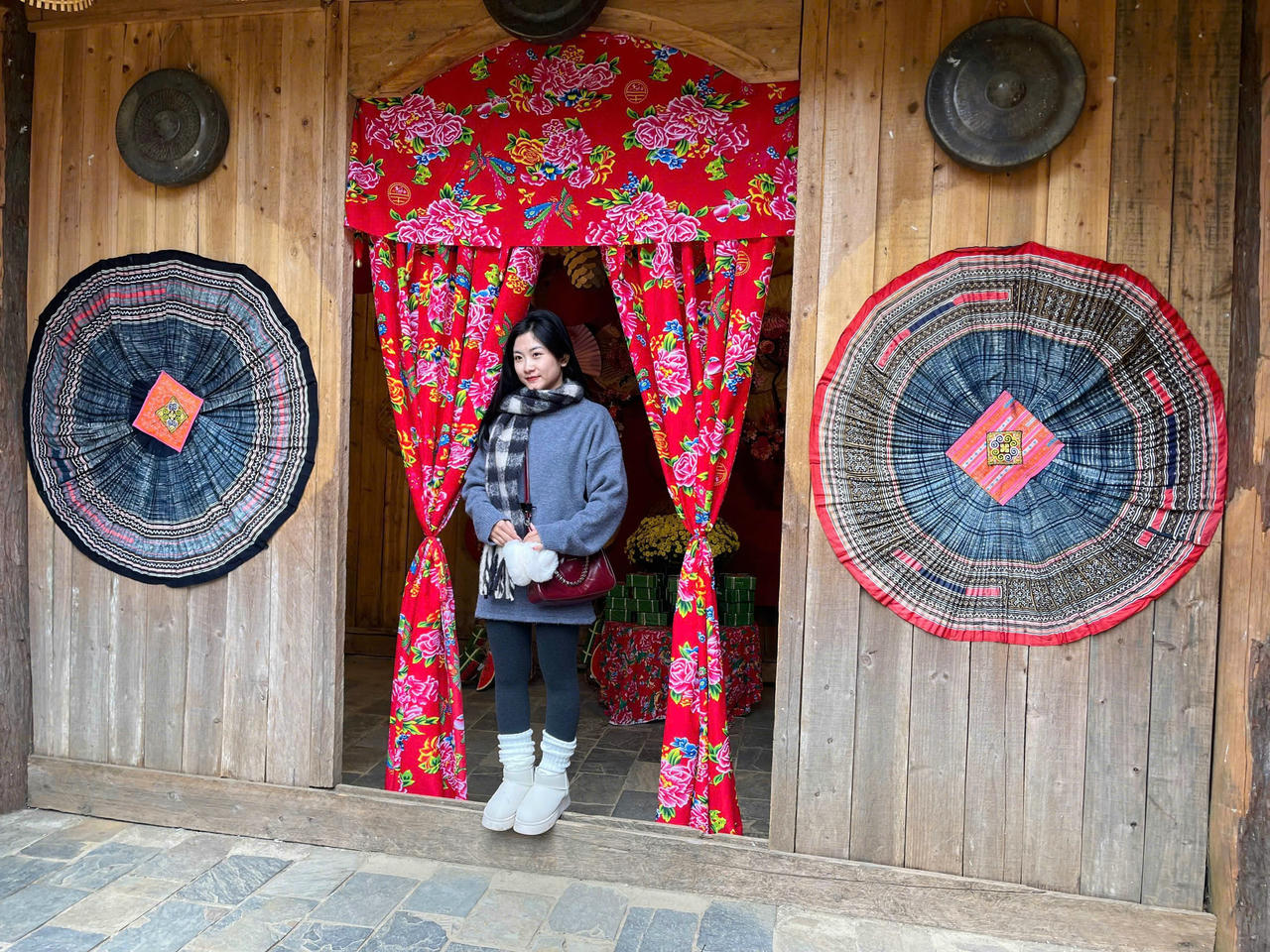
Unique brocade patterns of the HMong people. (Source: Collected)
In the afternoon, you can rent HMong ethnic costumes to transform into young men and women of the highlands and take photos beside the beautiful terraced fields.
In the evening, return to the homestay to rest, participate in a campfire, or watch folk art performances with the local people.
6.2. Second day: Conquering Fansipan peak
The new day begins with a trip to explore Fansipan peak, known as the “Roof of Indochina”. Visitors can travel by cable car to ensure safety and save time. From the Sun World Fansipan Legend cable car, you will admire the majestic panorama of the Northwest mountains and forests, floating white clouds, and terraced fields stretching out below.

Cable car takes tourists to conquer the legendary Fansipan mountain peak. (Source: Collected)
Sun World Fansipan Legend tourist area also boasts many impressive spiritual works such as: Heaven's Gate, Arhat path, Great Buddha statue, Bao An Zen Monastery… visitors can visit and worship in a tranquil space. Nature-loving tourists can visit the rose valley, where myriad flowers bloom amidst the cool weather.

Statue of the Great Buddha Ancestor proudly standing amidst the clouds and sky of Sapa. (Source: Collected)
At noon, stop by the Van Sam or Do Quyen buffet restaurant to enjoy piping hot highland specialties and recharge for your journey. The trip becomes complete when you touch the 3,143m milestone on Fansipan peak; take a photo to capture this memorable moment.
6.3. Third day: Explore Sapa center

Tourists with beautiful memories with the children of the HMong ethnic group. (Source: Collected)
In the morning, you can visit the Sa Pa stone church, the Sa Pa museum, and stroll around the town center. Don't forget to visit the local market or specialty stores to buy gifts for your loved ones, such as smoked buffalo meat, apple cider wine, and brocade fabric. Afterwards, tourists return to pack their luggage, concluding the journey fully with many memorable experiences in the poetic land of Sa Pa.
Cat Cat village embodies the charm of an ecological tourist destination, featuring unique local culture and increasingly refined services, making it suitable for a trip in 2025. If you wish to slow down, understand, and love every breath of the Northwestern mountains and forests, plan a trip to explore Cat Cat village to preserve beautiful memories with Sa Pa.








